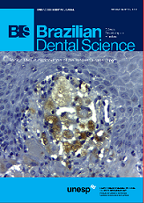Resin push-out bonding strength to root canal dentin: effect of the irrigation solution application prior to post cementation
DOI:
https://doi.org/10.14295/bds.2017.v20i2.1426Abstract
Objective: To evaluate the effect of different irrigation solutions prior to post cementation on the resin bonding to bovine root dentine. Material and Methods: 60 bovine roots (16 mm) were prepared to 12 mm with specific drill of a double-tapered fiber post system, included in PMMA, and divided into 6 groups, considering the irrigation solutions (IS) prior to cementation: Gr1- saline solution (control), Gr2- NaOCl 0.5 %, Gr3- NaOCl 1 %, Gr4- NaOCl 2.5 %, Gr5- NaOCl 5 %, Gr6- Chlorexidine 2 % (solution). The root canals were irrigated with IS 20 ml during 10 min. Then they were rinsed with 20 ml of distilled water and dried with paper points. One fiber post was molded with polyvinylsiloxane and 60 posts made of resin cement (PRC) were obtained moments before the cementation. The root canal dentin was etched with H2PO3 37 %/15 s + washing/drying, a multi-bottle etch&rinse adhesive system was applied and the PRC were resin luted with dual resin cement (DuolinkTM, Bisco). Each specimen was cut into 4 slices of ±1.8mm in thickness and submitted to push-out test (1 mm/min). Results: ANOVA showed that bond strength was significantly affected by IS (P<0.0001). The highest bond strengths (MPa) were those for the groups 4 (3.51 ± 1.52) and 5 (3.0 ± 1.16). The groups 1 (0.70 ± 0.30), 2 (0.80 ± 0.24), 3 (1.26 ± 0.57) and 6 (0.90 ± 0.41) were statistically similar to each other. Conclusion: The resin bonding to the root dentine was higher when higher concentrations of hypochlorite solutions were used.
Keywords
Bond strength; Irrigation solutions; Push-out test; Resin cement; Root canal dentin.
Downloads
Downloads
Published
How to Cite
Issue
Section
License
Brazilian Dental Science uses the Creative Commons (CC-BY 4.0) license, thus preserving the integrity of articles in an open access environment. The journal allows the author to retain publishing rights without restrictions.
=================




























